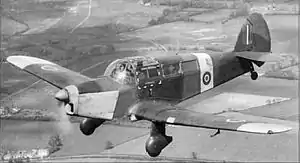| 756 Naval Air Squadron | |
|---|---|
| Active | 6 March 1941 - 1 December 1942 1 October 1943 - 24 November 1945[1] |
| Country | |
| Branch | |
| Type | Fleet Air Arm Second Line Squadron |
| Role |
|
| Part of | Fleet Air Arm |
| Insignia | |
| Identification Markings | X3A+ Proctor single letters Albacore KA+ Barracuda & Swordfish K1A+ Avenger[2] |

756 Naval Air Squadron (756 NAS) was a Naval Air Squadron of the Royal Navy's Fleet Air Arm. It was initially formed as a Telegraphist Air Gunner Training Squadron, operating from March 1941, out of RNAS Worthy Down (HMS Kestrel), in Hampshire, England. TAG training was provided until the No. 2 School was ready in Canada, opening on the 1 January 1943, and 756 NAS disbanded in December 1942. The squadron reformed at RNAS Katukurunda (HMS Ukussa), in Sri Lanka, in October 1943, as a Torpedo, Bomber, Reconnaissance pool. During 1944 and 1945, the squadron undertook a number of detachmemts on different types of Royal Navy aircraft carriers, with it disbanding in December 1945.
History of 756 NAS
Telegraphist Air Gunner Training Squadron (1941 - 1942)
756 Naval Air Squadron formed at RNAS Worthy Down (HMS Kestrel), 3.5 miles (6 km) north of Winchester, Hampshire, England, on 6 Mar 1941, as a Telegraphist Air Gunner Training Squadron.[3] It operated with Proctor I and II, a British radio trainer and communications aircraft.[4]
The squadron continued Telegraphist Air Gunner training throughout 1942, however, as part of the British Commonwealth Air Training Plan, the No. 2 Telegraphist Air Gunner School, at R.N. Air Section Yarmouth , located in Yarmouth County, Nova Scotia, Canada, opened on 1 January 1943,[3] and therefore 756 NAS was disbanded at Worthy Down on the 1 December 1942.[4]
Torpedo Bomber Reconnaissance (1943 - 1945)
756 Naval Air Squadron reformed on the 1 October 1943 as a Torpedo Bomber Reconnaissance pool at RNAS Katukurunda (HMS Ukussa), located near the town of Kalutara in Sri Lanka. The squadron initially used Albacore, a single-engine biplane torpedo bomber, and Fulmar, a British carrier-borne reconnaissance aircraft/fighter aircraft, from reformation. These were followed by Barracuda, a British carrier-borne torpedo and dive bomber, in the December. In February 1944, Albacore and Fulmar were withdrawn from the squadron's inventory, but Swordfish, a biplane torpedo bomber aircraft, arrived in March 1944 and these were closely followed by Avenger, an American torpedo bomber aircraft, in May.[4]
The squadron participated in four separate aircraft carrier deployments, one during 1944 and a further three in 1945. From the 29 April to the 4 May 1944, a detachment from 756 NAS, was deployed on the aircraft repair ship and light aircraft carrier, HMS Unicorn (I72).
In 1945, a detachment then spent three days, 1, 2 and 3 May, operating from the Attacker-class escort carrier, HMS Attacker (D02) and this was later followed by a two week detachment to the Ruler-class escort carrier, HMS Atheling (D51), between the 15 and the 21 August. 756 NAS sent a detachment to the Illustrious-class aircraft carrier, HMS Victorious (R38) for approximately two weeks, from 29 October to the 12 November.[4]
On the 24 November 1945, 756 NAS disbanded at RNAS Katukurunda.[4]
Aircraft flown
756 Naval Air Squadron has flown a number of different aircraft types, including:[4]
- Percival P.28 Proctor IA (Mar 1941 - Dec 1942)
- Percival P.30 Proctor IIA (Mar 1941 - Dec 1942)
- de Havilland (DH.82A) Tiger Moth II (Dec 1941 - Jun 1942)
- Fairey Albacore Mk I (Oct 1943 - Feb 1944)
- Fairey Fulmar Mk.II (Oct 1943 - Feb 1944)
- Fairey Barracuda Mk II (Dec 1943 - Nov 1945)
- Fairey Barracuda Mk III (Dec 1943 - Nov 1945)
- Fairey Swordfish I (Mar 1944 - Feb 1945)
- Grumman Tarpon GR.I (May 1944 - Nov 1945)
- Grumman Avenger Mk.II (May 1944 - Nov 1945)
Naval Air Stations and Aircraft Carriers
756 Naval Air Squadron operated from a couple of naval air stations of the Royal Navy, one in England and one overseas in Sri Lanka, and some Royal Navy aircraft carrier deployments[4] (Dt.= Detachment):
- Royal Naval Air Station WORTHY DOWN (6 Mar 1941 - 1 December 1942)
- Royal Naval Air Station KATUKURUNDA (1 October 1943 - 24 November 1945)
- HMS Unicorn Dt. (29 April 1944 - 4 May 1944)
- HMS Attacker Dt. (1 May 1945 - 3 May 1945)
- HMS Atheling Dt. (15 August 1945 - 21 August 1945)
- HMS Victorious Dt. (29 October 1945 - 12 November 1945)
Commanding Officers
List of commanding officers of 756 Naval Air Squadron with month and year of appointment and end:[4][2]
1941 - 1942
1943 - 1945
References
Citations
- ↑ Sturtivant, Ballance 1994, p. 75.
- 1 2 Wragg 2019, p. 125.
Bibliography
- Sturtivant, R; Ballance, T (1994). The Squadrons of The Fleet Air Arm. Tonbridge, Kent, UK: Air-Britain (Historians) Ltd. ISBN 0-85130-223-8.
- Wragg, David (2019). The Fleet Air Arm Handbook 1939-1945. Cheltenham, Gloucestershire, UK: The History Press. ISBN 978-0-7509-9303-6.